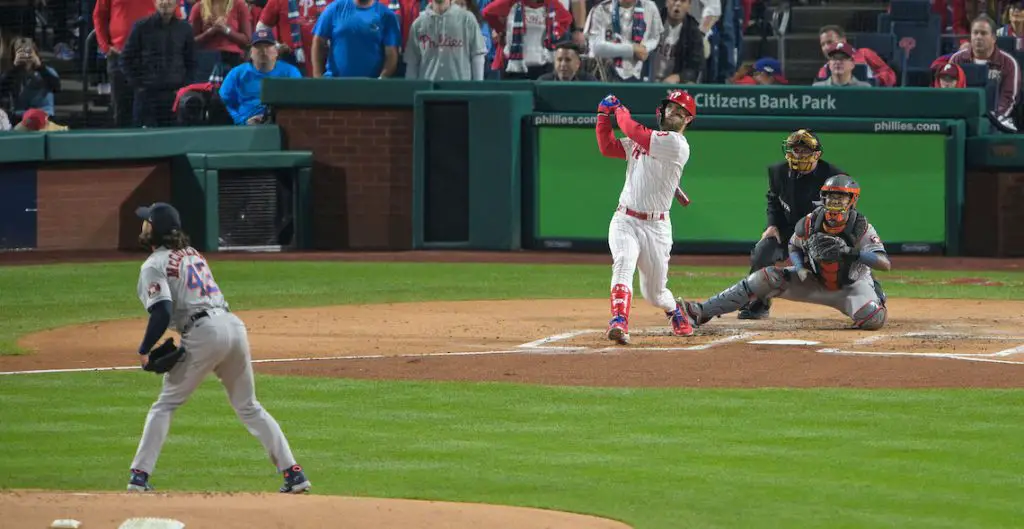
John Geliebter/USA TODAY Sports
Last night, Game 3 of the World Series squared off in South Philly, and the surging offensive firepower of the Philadelphia Phillies found a way to win a crucial game at home powered by five home runs.
The Phillies beat the Houston Astros soundly, 7-0, and the Philly bats pounced on Houston starter Lance McCullers Jr., hitting five home runs and tallying seven earned runs. It’s the most home runs by a pitcher in a single game in World Series history. Bryce Harper, Kyle Schwarber, Rhys Hoskins, Brandon Marsh, and Alec Bohm all homered in the game. At one point, Schwarber and Hoskins hit back-to-back dingers.
This development is a pretty astounding one. Before Game 3 of the World Series, Lance McCullers had gone 651 off-speed pitches without allowing a single home run. His most dominant pitch went from being virtually unstoppable to being fallible.
Conversations on social media during the game and on the morning talk shows have fueled discussion of whether the Astros pitcher tipped his pitches.
What is a tipped pitch?
In baseball, the only thing standing in the way of the opposing team generating offense is the pitcher. Strike him out and get three outs, and the team moves to the next inning, looking to score runs. It’s up to the batter to determine which pitch is coming and make something happen.
There is a code system that a pitcher uses to communicate with his catcher, allowing them a discrete way to call pitches. But, there are some instances, including a tipped pitch, when a pitcher unknowingly displays signals, either with signs or motions, about what pitch is coming.
There are a few ways this can happen that can tip the batter off to what pitch is coming:
- How a pitcher stands on the rubber
- A tweak or variance in pitching motion
- How a pitcher holds the ball immediately before pitching
- Positioning of the glove at the top of a pitcher’s delivery
In the case of McCullers, some analysts doing the talking head circuit this morning indicate that the mechanics of McCullers’ delivery was key to the hit parade.
How players look for advantages
Hitters are always looking for advantages. Advanced metrics, data, and video scouting provide ample opportunities for players to study before and during a game.
Many teams assign hitting coaches or players who are not on the field to study video footage and look to find a crack in the baseball code — anything that can provide an advantage.
Last night, Harper was seen giving Bohm advice in the on-deck circle. Then, during his at-bat, Bohm smacked a homer. Asked by Fox analyst Ken Rosenthal about the exchange, Bohm only said the talk was private between them.
Other moments of tipped pitches in baseball lore
The topic of tipped pitches has come up now and again, especially in the last couple of decades. Here are two examples:
- New York Yankee slugger Alex Rodriguez stirred up a controversy when author Selena Roberts accused the former star of tipping pitches — to the opposing team. The likely story is that Rodriguez preferred to take an active leadership role on the team, and in doing so, he was communicating tells of pitches to his team, but in a clear view of the opposing team.
- In Game 2 of the 2001 World Series, Diamondback player Mark Grace noticed something. Opposing Yankees pitcher Andy Pettitte hesitated barely a second in his delivery. In Game 6, the Diamondbacks put the puzzle together: When he paused, a fastball was coming, and when he did not pause, they would see curveballs. Pettitte didn’t last more than three innings and allowed six runs and seven hits.
- In the 2017 World Series, Dodgers ace (currently with the Padres) Yu Darvish was thought to have tipped his pitches against the Houston Astros. In a deciding Game 7, Darvish was rocked, giving up five runs in 1 2/3 innings. After the World Series, he studied the video and could not find any significant tells that tipped his pitches. Instead, he blamed himself.
“I feel that if I absolve myself and say it was the Astros’ fault I was bad in Game 7, in the World Series, I can’t develop as a person,” Darvish said. “In life, I think huge failures are extremely important. I’ve had a few up to this point. The World Series was one of them. I think it will remain a point of reference for me. I’ve already learned a lot from it. So regarding that, I can’t view myself charitably. I think I have to continue to accept the results.”
It’s not like the pitchers or managers will admit they were tipping pitches. In the case of Pettitte in the 2001 World Series, Yankees manager Joe Torre just said he has a tendency to show a breaking ball occasionally and that he was not bringing his best stuff with the curveball.